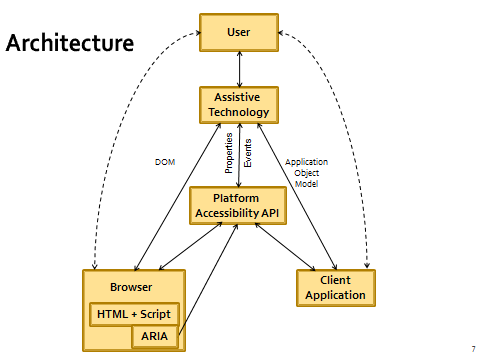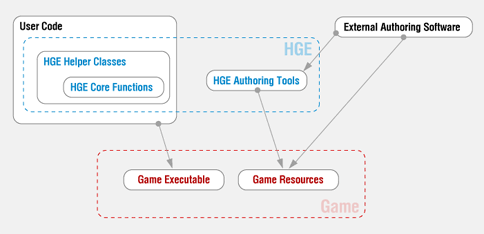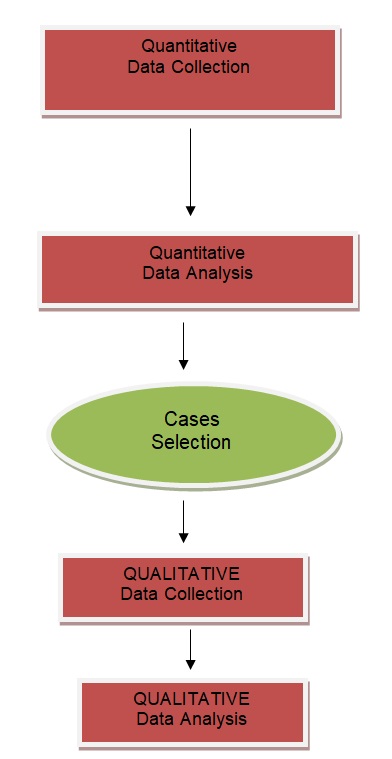Introduction
E-learning system use complicated technology which entails web-based integrated communications interfaces that supports shared calendaring, file sharing, email and document publishing (Akar et al., 2004). Web accessibility entails making information and technology practical to the people with disabilities. The difference comes as a result of physical disabilities and Cognitive and neurology, where the learners require some input devices rather than keyboard and mouse. However, some may require special screen reader and voice recognition devices. Various principles and regulations have been introduced to satisfy and justify multiple users anecdotal with disability. Different types of element and objects can be used to code tools which can be recognized by keyboards. Windows developers emphasize on specific objects to code the opposite convenience web properties (Bleimann, 2004). A combination of document object model UI automation and HTML elements require API for coding. Information technology impact on e-learning is remarkable and requires a broad analysis. “Realizing the potential of ICT needs to be accompanied by the necessary resources and human support, together with social and institutional environment that is open to innovation and change” (Rubens and Heinze 2007, p. 56). This paper consists of a proposal for project which will explore e-leaning information system for advanced support accessibility.
Research Aims
This project will investigate a variety of tools that are used in e-learning to enhance accessibility of learning materials by both educators and students of higher institutions of learning (Dearnley, 2003). Use of HTML elements will be coded to text to speech software to bring forth semantic links and images which can assist the blind learners to interpret text. Color will be used to underline links for visual impairments and switch devices for learners who cannot access mouse as a result of tremors or diseases. This will be put into practice by use of standard keyboard. The research project is aimed at identifying the nature of e-learning information system accessibility, in the context of advanced technology. There is a continued need to provide innovative improvements on e-learning information system accessibility, to match with the changing needs of information technology (Angelina, 2002). It is not a surprise to find institutions of higher learning using outdated technology to provide access to their e-leaning services, particularly at the expense of users with disability. In particular, the study will focus on those tools that support access by disabled users, brought about by current e-learning’s new technological advancement. The study aims at focus precisely on web accessibility which results from emergent and advanced technology; and to propose ways of developing better tools and approaches for e-learning accessibility development (Grooms, 2003).
The general overview of the area
Issues of functionality, usability and sustainability have become very critical in e-learning and its environs, and enhancement of functionality by Assistive Technology. Nevertheless, information and technology programming codes which includes MY SQL, JAVA SCRIPT, HTML, Pascal, C++, and C can contribute to high quality voice recognition. Screen reader software for the blind in applications like Microsoft window internet explorer will be critically explored. Although many studies have concentrated on the functionality, usability and sustainability of e-learning environment, little attention has been paid to accessibility by the disabled users. Accessibility of e-learning study materials can be enhanced through technological improvements and innovation of new tools with high functionality (Haigh, 2004).

The architecture above illustrates the web accessibility based on Microsoft windows Assistive technology. The user will send text via Assistive technology. The browser will interpret the HTML and JAVA SCRIPT codes through ARIA, then back to platform accessibility API to client application.
Literature Review
As internet and computer technology gains a wide spread attractiveness, as more and more people are turning to e-leaning. Due to its flexible nature, e-learning attracts and is expected to continue attracting crowds of learners across the globe. Uys (2003) provided that e-learning process requires appropriate internet infrastructure and Physical disabilities. Keyboards or switches should be used to cater for learners with arms and hand disabilities (Yong, 2003). Puff-switches and eye-gaze switches includes some features like key space size and types which allow operation of keyboard without a mouse as input devices (Chadha, 2002). Time rejoinder tools that do not allow keyboard options in browsers and forms which cannot be tabbed limit web page access. Voice recognition equipments should be enhanced to assist people with Speech disabilities (Carr, 1999).
Blind people and those with dyslexia problem fall under Cognitive and neurological disability, and need voice recognition and screen readers to assist them in reading blocks of data on web pages. “In addition to the limited internet coverage, technological backups and factors, such as limited bandwidth are considered in e-learning today, where fast DSL connections were introduced to replace outdated 14.4 Kbps bandwidth” ( Kumail 2002, p.28).
Pachnowski (2003) added that the high speed DSL connection have improved video conferencing and enhanced recovery of lost audio and delays class start time. Shockingly, “the learners who depend on dial-up connection from their homes may enjoy video conferencing effectively, particularly due to high speed bandwidth connection” (Baker 2003, p.56). Ivergard and Hunt (2005) pointed out that a better design “gave users a feeling morale of the system” (p. 45). The needs of the learners should be the basis upon which the courseware should be designed. The learners, for instance, should not have problems accessing information together with guidance (Howell, Williams and Lindsay, 2003; James-Gordon and Young and a Bal, 2003). The courseware ought to incorporate other aspects that enhance e-leaning. Svenson (2004) maintained that encoding a system with basic programming languages such as SCRIPT language, HTML, Pascal Visual Basic and C++ can bring forth sensible software for accessibility.
Key research questions
The research will seek to answerer the following questions:
- what factors can learners consider in online information system to access e-learning programs (especially considering the advancement of technology that characterize e-leaning environment)?
- What are some of the features that can be incorporated into e-leaning interface to improve its accessibility to more advanced technology?
- How can e-learning access issues be solved practically?
- What are some of the implications of technological advancement on e-learning interfaces?
- How can e-learning information system get enhanced to facilitate accessibility by disabled people?
Methodology
Several types of methods will be used in this study (Tashakkori and Teddlie, 2003). Programming method such as object oriented programming which defines the data behavior coupled with program run time error will be used. Programming languages will assist in eradication of communication crisis. Visual basic is among the programming language that will be used to code control software. In addition, HTML will be used to code software to convert message links to voice recognition and screen reader.
HTML will use elements, objects and tables to criticize controls for the blind apprentices. System analysis and design methods such as MY SQL will be used in this study. This technique involves mixing both qualitative and quantitative data to understand research problem fully (Creswell, 2002). The complexity of e-learning environment cannot be sufficiently explored without mixing the two methods. In quantitative research, numerical data will be relied upon (Charles and Mertler, 2002). Postpositivist assertions will be used to establish the reduction to specific variables and causes and effect notion. On the other hand, qualitative research is “an inquiry process of understanding where the researcher develops a complex, holistic picture, analyzes words, reports detailed views of informants, and conducts the study in a natural setting” (Creswell 1998, p. 15). Knowledge building will be built on the basis of constructivist or participatory viewpoints (Guba and Lincoln, 1982).
Implementation of technology methods will enhance voice and display gratitude to avoid limitation of mouse and screen function (Pachnowski, 2003). Windows developers will emphasize on specific objects to code the apposite convenience web properties. A combination of document object model UI automation and HTML elements will be required API for coding.
Software development methodology will use an extreme programming language which uses time boxing and cycles to increase the eminence of software. It will mainly focus on productivity of more e-learners. In this method, we will review and test the codes to check whether the project is functioning well. Answers to the research questions will result from choice of the most appropriate units of analysis and variables (Tashakkori and Teddlie, 1998). This study will use explanatory sequential mixed methods design which is very popular in technical research (Creswell, 2002; Creswell et al., 2003). The study will involve two phases, where in the first phase; a web-based survey will be conducted. This phase will aim at collecting quantitative-numeric data. In addition, this phase will serve the purpose of identifying the variables with predictive power, upon the users of e-learning information system.

The second phase will involve qualitative case study approach. This approach will facilitate collection of text data through elicitation materials and documents. The goal of this phase is to explain the reasons why the internal and external factors, investigated in the first phase, may be strong indicators of e-learning accessibility.
All the items in each group will be summed up to identify the key factors which affect e-learning activities. Data reduction for every group will be conducted with the aim of identifying key factors. varimax with Kasiser Normalization will be used to establish the rotated matrix component. Correlation analysis will then be carried out to establish the impact of each element. In addition, the evidence will be documented through narrative accounts, observations as well as applying emerging technologies of recording and analyzing data (Ndahi, 2006).

Time scale /research planning
- Year one, first half – this will be set aside for the research preparations and training. Literature reviews sources shall be gathered while at the same time decide on the research questions. This period will also be used to establish contacts with the possible participants.
- Year one, second half- the research methods will be developed in addition to preparation of appropriate instruments.
- Year two, first half-the empirical phase of the study will be undertaken
- Year two, second half-the literature review together with results analysis will be carried out.
- Year three, first half-wrapping up on the writing tasks.
References
Akar, E., Ozturk, E., Tuncer, B. and Wiethoff, M., 2004. Evaluation of a collaborative virtual learning environment. Education + Training, 46(6/7), pp. 343-352.
Angelina, P., 2002. E-learning: The alternative leaning process. The Star Tech Plus, pp.9-12.
Baker, R. K., 2003. A Framework for Design and Evaluation of Internet-Based Distance Learning Courses Phase One – Framework Justification, Design and Evaluation. Online Journal of Distance Learning Administration, 6(2).
Bleimann, U., 2004. Atlantis University: a new pedagogical approach beyond e-learning. Campus-wide Information Systems, 21(5), pp.191-195.
Carr, J., 1999. The role of higher education in the effective delivery of multimedia management training to small and medium enterprises. Educational Technology & Society, 2(2).
Charles, C. M. and Mertler, C. A., 2002. Introduction to educational research (4th ed.). Boston, MA: Allyn and Bacon.
Collins, G.R., 2002. Case Study: A Satellite-based Internet Learning System for the Hospitality Industry. Online Journal of Distance Learning Administration, 5 (4).
Creswell, J. W., 2002. Educational research: Planning, conducting, and evaluating quantitative and qualitative approaches to research. Upper Saddle River, NJ: Merrill/Pearson Education.
Creswell, J. W., 1998. Qualitative inquiry and research design: Choosing among five traditions. Thousand Oaks, CA: Sage Publications.
Creswell, J. W., Plano Clark, V. L., Guttman, M., and Hanson, W., 2003. Advanced mixed methods research designs. In: A. Tashakkori & C. Teddlie (Eds.), Handbook on mixed methods in the behavioral and social sciences, pp. 209-240. Thousand Oaks, CA: Sage Publications.
Dearnley, C., 2003. Student Support in Open Learning: Sustaining the process. International Review of Research in Open and Distance Learning, 4(1), pp.56-57.
Friesen, N., 2004. Three Objections to Learning Objects. Web.
Gordon, Y., Young, A. & Bal, J., 2003. External environment forces affecting e-learning provider. Marketing Intelligence & Planning, 21(3), pp.168- 172.
Grooms, L.D., 2003. Computer-Mediated Communication: A Vehicle for Learning. International Review of Research in Open and Distance Learning, 4(2).
Guba, E., and Lincoln, Y., 1982. Winter. Epistemological and methodological bases of naturalistic inquiry. Educational Communications and Technology Journal, pp. 232-252.
Haigh, J., 2004. Information technology in health professional education: why IT matters. Nurse Education Today, 2004(24), pp.547-552.
Henly, R., 2003. Inclusive pedagogy: Teaching methodologies to reach diverse learners in science instruction. Equity & Excellence in Education, 40(3), pp. 252-265.
Howell, S.L., Williams, P.B. and Lindsay, N.K., 2003. Thirty-two Trends Affecting Distance Education. An Informed Foundation for Strategic Planning’, Online Journal of Distance Learning Administration, 6 (3).
Ivergard, T. and Hunt, B., 2005.Towards a learning networked organization: human capital. compatibility and usability in e-learning systems, Applied Ergonomics, 2005(36), pp.157-167.
Kearsley, G., 2000. Teaching & Learning in Cyberspace. Web.
Moriarty, M., 2007. Inclusive pedagogy: Teaching methodologies to reach diverse learners in science instruction. Equity & Excellence in Education, 40(3), pp. 252-265.
Ndahi, H., 2006. The use of innovative methods to deliver technology education laboratory courses via distance learning: A strategy to increase enrollment. Journal of Technology Education, 17(2), pp. 33-42.
Pachnowski, L.M and Jurczyk, J.P., 2003. Perceptions of Faculty on the Effect of Distance Learning Technology on Faculty Preparation Time. Online Journal of Distance Learning Administration, 6(3).
Pearson, E., and Koppi, T., 2002. Inclusion and online learning opportunities: Designing for accessibility. ALT-J, 10(2), pp. 17-28.
Rubens, W. and Heinze, O., 2007. Portfolio as a tool for academic education and professional development: problems and challenges, IVLOS Institute of Education, Utrecht University. Web.
Sambrook, S., 2003. E-learning in Small Organizations. Education + Training, 45(.8/9), pp. 506-516.
Seale, J., 2001. E-learning and accessibility: an exploration of the potential role of generic pedagogical tools. Journal of computer science, 54(4)
Smulders, D., 2003. Designing for Learners, Designing for Users’, E-Learn Magazine, Association of Computing Machinery. Web.
Svensson, L., 2004. Challenges for work-integrated e-learning: The case of the Swedish Academy of County Administrators. Journal of Workplace Learning, 16 (8), pp.492-502.
Tashakkori, A., and Teddlie, C., 1998. Mixed methodology: Combining qualitative and quantitative approaches. Applied Social Research Methods Series, 46. Thousand Oaks, CA: Sage Publications.
Thompson, T., Burgstahler, S., and Comden, D., 2003. Research on Web accessibility in higher education. Journal of Information Technology and Disabilities, 9(2).
Uys, P.M., 2003, Critical Success Factors in the Infusion of Instructional Technologies for Open Learning in Development Settings: The Case of the University of Botswana, International Review of Research in Open and Distance Learning, 4(2).
Yip, M., 2004. Using Web-CT to teach courses online. British Journal of Educational Technology, 35(4), pp.497-501.
Yong, A., 2003, Success factors in e-learning Implementation. The Star In.Tech, p.19.